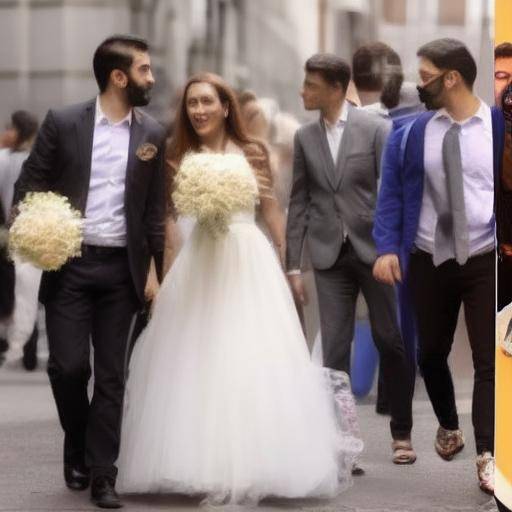
The wedding day is one of the most significant moments in a couple's life. The choice of nuptial clothing is not only a personal expression, but it is also permeated with cultural and symbolic meanings that have evolved over time. In this article, we will explore the fascinating history and evolution of the wedding dress, as well as the marriage symbolism that hides behind every detail. In addition, we will offer practical advice and reflections on future trends in the bridal field. Get ready to dive into the exciting world of wedding dress!
Introduction
The wedding day is an event full of tradition and symbolism. Since time immemorial, the wedding garment has been a focal point in marriage ceremonies, reflecting the culture, religion and trends of the time. Throughout history, we have witnessed significant changes in the styles and meanings associated with the wedding garment, which sheds light on the evolution of marriage and the social beliefs that surround it.
In this article, we will undertake a journey through time to discover how the wedding garment has evolved, from ancient times to present. We will explore the symbolism behind each element of the wedding garment, highlighting its importance in different cultures and communities. In addition, we will provide valuable advice to those who are preparing for their own special day, along with projections on future trends in the wedding world.
Get ready for a journey through the history, evolution and symbolism of wedding dress!
History and Background
The wedding garment has deep roots in history and has evolved significantly over the centuries. From the weddings of ancient Greece to the opulent costumes of the Renaissance, each period of history has left its mark on the way boyfriends and girlfriends dress.
Antiquity: The Influence of First Civilizations
In ancient civilizations, such as Egyptian and Greek, the nuptial garment was strongly influenced by religious beliefs and cultural traditions. For example, in ancient Egypt, the red color was associated with love and fertility, and brides wore robes of this color at their weddings. Meanwhile, in ancient Greece, brides wore distinctive veils to chase away evil spirits and protect themselves from envy.
Middle Ages: Opulence and Symbolism
During the Middle Ages, the wedding garment became more elaborate and symbolic. The suits of the brides and grooms were exquisite pieces of craft, adorned with lace, embroidery and jewellery. The use of the bride veil was popularized as a symbol of purity and modesty, while the white color began to associate with innocence and virginity.
Renaissance: The Influence of Fashion and Nobleness
During the Renaissance, fashion and opulence reached their peak in the nuptial garment. The costumes were dazzling, with luxurious fabrics and embroidery made. At this time, white was consolidated as the predominant color for brides, symbolizing purity and innocence. The garment reflected social status, and the noble families competed to dazzle with their wedding costumes.
Conclusion
Throughout history, the nuptial garment has encapsulated the beliefs, traditions and tendencies of each time, significantly evolving to reflect the transformation of societies and conceptions about marriage. From antiquity to the modern era, every culture and period of time has left an indelible mark on the way we celebrate love through the wedding garment.
The evolution of wedding garments and marriage symbolism is a testimony to the constant change and adaptation throughout time. As we continue to advance in the twenty-first century, it is exciting to see how these traditions will continue to transform and adapt to new social and cultural realities.
Ultimately, the nuptial garment is not only an external manifestation of love and commitment, but also a profound reflection of the history, culture and society in which it is celebrated. Whether a bride chooses a traditional or modern dress, or a boyfriend chooses a classic tuxedo or a contemporary suit, each choice carries with it the wealth of nuptial evolution and symbolism rooted in every detail.
We hope that this journey through the evolution and symbolism of the bridal garment has been revealing and enriching. Whether you are planning your own wedding, interested in history and culture, or simply curious about this beautiful aspect of life, the wedding garment will remain a lasting reminder of the multiple layers of meaning that intertwine in the fabric of love and commitment.
Frequently Asked Questions about Nuptial Dress, Evolution and Matrimonial Symbolism
- What is the origin of the bride veil and its symbolism?
- How has the color choice of the wedding dress evolved throughout history?
- At present, have the traditions of nuptial clothing changed in different cultures?
- What symbolizes the use of certain jewelry or accessories in the wedding dress?
- What are the current trends in wedding dress and how do they reflect the evolution of modern weddings?
- What is the symbolism behind the choice of the groom suit?
These frequent questions provide a deeper and clearer view of the nuptial garment, its evolution over time and the symbolic meaning that encloses every detail.
With this article, it is expected to give an enriching and revealing look on the evolution and symbolism of the wedding garment. From historical origins to contemporary trends, this tour offers a deeper appreciation of the rich tapestry of meanings that intertwine in the nuptial garment over the centuries.
